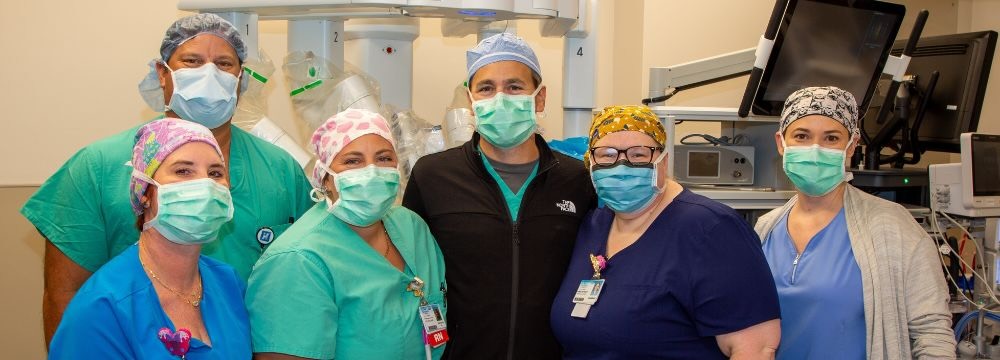Archives: September 2025
From Lap-Band® to Lasting Results: Removing or Converting Your Gastric Band

When the FDA approved the Lap-Band® in 2001, it was a revolutionary medical device. Patients had an adjustable and fully reversible bariatric surgical procedure for the first time.
Up to that point, procedures in Europe and Australia were considered equivalent to gastric bypass; the only surgical alternatives were more invasive, often open operations involving stomach stapling. With the new gastric band technology came incredible hype, marketing, and a boom in band placements. Over the next decade and a half, hundreds of thousands of patients had bands placed in their bodies with varying degrees of success.
Over time, while some patients lost a significant amount of weight, the band had some critical drawbacks. Unlike most other bariatric procedures, it offers no hormonal or malabsorptive benefits – weight loss relies solely on the band’s restriction. Hunger persisted, yet recipients could no longer eat as much as before.
More concerningly, the complication rates of the band over the long term became untenable. There was slippage of the band, where it moved out of place and caused significant symptoms or a lack of restriction; other patients experienced erosion of the band into the esophagus. Some patients even experienced flippage of the injection port used to adjust the band.
All of these complications required further surgery, and patients were not achieving the kind of excess body weight loss that stapled surgical procedures, such as a gastric bypass or gastric sleeve, offered.
How We Convert a Gastric Band
If you’re wondering why we don’t simply remove the band, it’s because once the restriction is gone, significant weight regain usually follows. While a band could theoretically be replaced, most patients opt for a conversion to a stapled procedure instead, avoiding the long-term risks of repeated band complications.
Because the band does not permanently alter the anatomy of the gastrointestinal tract, patients requiring a conversion have the option of any other bariatric surgery, including the gastric sleeve, gastric bypass, or, for patients with relatively higher BMIs, a duodenal switch or SADI.
What Is the Operation Like
Patients are under general anesthesia for the entire procedure, which starts with the removal of the band. The contents of the band are drained, the band cuff is cut, and then it’s removed from the abdomen. The conversion procedure is then performed almost as if it were the primary bariatric surgery.
The entire procedure takes approximately one to two hours, depending on the type of surgery being performed and the condition of the band. The downside is that potential risks and complications of the conversion procedure are higher due to the presence of scar tissue from the initial band placement.
That said, patients who tackle weight regain early enough (i.e., at a lower weight and in a healthier state) may actually have a lower surgical risk than they did during their initial procedure. If the band has eroded into the esophagus, however, your surgeon may delay the conversion procedure and perform it separately once the stomach and/or esophageal tissue has healed.
Choosing the Right Surgeon for a Conversion
Among the many decisions a patient faces, choosing the right surgeon for a revision procedure is critical. Conversion operations are complex, and selecting the most appropriate surgical method is equally important.
Choosing an experienced surgeon with an impeccable track record in all major bariatric procedures, including the sleeve, bypass, duodenal switch, and SADI, ensures that you receive proper guidance without inherent bias for one procedure or another. Furthermore, a highly skilled surgeon in conversion procedures may have a better understanding of the complexities and potential complications that may arise during surgery.
If your gastric band/lap band is functioning well and you’re not experiencing complications, a revision may not be necessary. Revisions are typically reserved for patients facing significant weight regain or band-related issues.
At SAMPA, we welcome your questions and can help you determine if a conversion surgery is right for you. Contact our team today to schedule a consultation and explore your options with an experienced conversion bariatric surgeon.
A Local Surgeon and Global Technology: Dr. Ballard and the da Vinci Advantage

For many patients, surgery comes with two big questions: Who will be performing it? And what tools will they be using? At Surgical Association of Mobile, you don’t have to choose between expertise and innovation. With Dr. Barry Ballard and the da Vinci Surgical System, patients get both: the steady hand of a trusted local surgeon and the precision of world-class technology.
Just how innovative is this? The procedures Dr. Ballard has performed using the da Vinci technology were the very first to be done in an outpatient surgical center in Alabama – a groundbreaking moment that brings cutting-edge care closer to home.
Meet Dr. Barry Ballard
Born and raised in Mobile, Dr. Ballard knew from the time he was in high school that surgery was his calling. He got his start scrubbing in as an orderly at Springhill Memorial Hospital, and after completing his medical degree at the University of South Alabama and his general surgery residency at the University of South Alabama Medical Center, he chose to stay home to serve the community that shaped him.
Dr. Ballard is a Fellow of the American College of Surgeons and an active member of leading surgical associations. His specialties include:
- Bariatric surgery, including gastric bypass and sleeve gastrectomy
- Hernia repair
- Colon and rectal surgery
- Gallbladder removal
- Thyroid and parathyroid surgery
- Treatment for GERD and chronic acid reflux
Most importantly, Dr. Ballard is known for his patient-first approach. He listens, explains, and makes sure every individual understands their options before moving forward.
What Is the da Vinci Surgical System?
It’s easy to assume the word “robot” means the machine is operating on its own. In reality, da Vinci is a surgeon-controlled system, acting as a highly advanced tool that extends a surgeon’s vision and movement beyond what’s possible with the human hand alone.
From the surgeon’s console, Dr. Ballard controls tiny wristed instruments that can bend and rotate far more precisely than the human wrist. The system translates his movements into real-time surgical action – steady, scaled, and precise.
What Does This Mean For Patients?
- Smaller incisions and less scarring
- Less blood loss and reduced risk of complications
- Less pain after surgery
- Faster recovery and return to daily life
The da Vinci technology enables Dr. Ballard to perform complex procedures through minimally invasive approaches that were once only possible with open surgery.
Features in Everyday Language
The da Vinci offers features that sound high-tech on paper, but this is how it breaks down:
- Sharper vision for the surgeon: Dr. Ballard sees the abdominal anatomy in magnified 3D detail, down to tiny vessels and tissues.
- Real-time guidance: Firefly technology illuminates blood flow and bile ducts, enabling Dr. Ballard to protect delicate structures.
- Greater flexibility: The system’s wristed instruments move with more agility than the human hand, allowing Dr. Ballard to navigate tight spaces with ease.
What makes the da Vinci system remarkable isn’t the technology alone, but what happens when it’s placed in the hands of a surgeon like Dr. Ballard: someone who combines hometown dedication with world-class training and precision.
With Dr. Ballard and the da Vinci, patients can trust they’re receiving advanced care that’s both cutting-edge and compassionate.
da Vinci FAQ
Is robotic surgery safe?
Yes. Robotic surgery is not an “autopilot” system – da Vinci is completely controlled by Dr. Ballard. The technology simply enhances his vision and precision. Like any surgery, there are risks, but robotic surgery is considered very safe and has been performed in millions of procedures worldwide.
Will a robot perform my surgery?
No. Dr. Ballard performs every aspect of your procedure. The da Vinci system is a set of advanced tools that extend his capabilities, allowing him to work through smaller incisions with greater accuracy.
What types of procedures can Dr. Ballard perform with da Vinci?
Dr. Ballard uses the da Vinci for a variety of bariatric and general surgeries, including gastric bypass, sleeve gastrectomy, hernia repair, gallbladder removal, and more.
How do I know if I’m a candidate for robotic surgery?
Not every procedure or patient is suited for robotic surgery. Dr. Ballard will meet with you, review your medical history, and determine whether robotic surgery is the safest and most effective option for your situation.
What should I expect during recovery?
While recovery varies by procedure and individual, most patients experience less pain, shorter hospital stays, and faster healing compared to open surgery. Dr. Ballard and his team will give you a personalized recovery plan.

